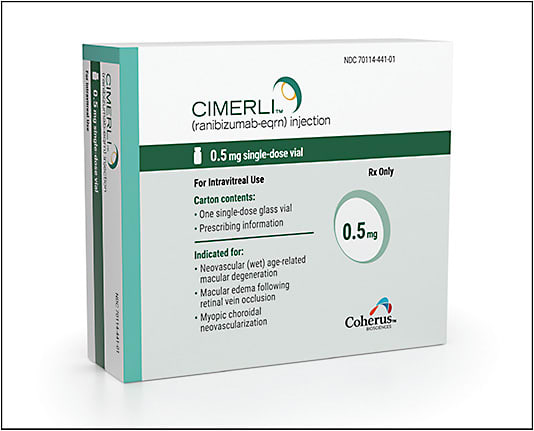In 2006, one of the first anti-VEGF agents, ranibizumab (Lucentis; Genentech) gained FDA approval. Ranibizumab greatly changed the landscape of treatments for neovascular (wet) age-related macular degeneration (AMD), diabetic macular edema (DME), and several other retinal conditions. “These diseases used to lead to inevitable blindness; now there was a treatment that allowed people to maintain their vision,” says David M. Brown, MD, FACS, director of research at Retina Consultants of Texas and clinical professor of ophthalmology at Baylor College of Medicine in Houston.
With the patent for Lucentis expiring in 2020, Coherus BioSciences of Redwood City, California, saw an opportunity to create a biosimilar product that would be interchangeable with Lucentis. In August 2022 the FDA approved Cimerli (ranibizumab-eqrn), which Coherus offered at a price 30% lower than the Lucentis wholesale acquisition cost.
Dr. Brown, who has used Cimerli at his practice, says the lower-cost medication is a game changer. “The ability to have a biosimilar ranibizumab with the same technology and efficacy as Lucentis, but at a lower price, is a tremendous opportunity,” he says. “We can potentially offer patients lower priced drugs and lower copays, as well as help to ensure that copay assistance dollars go further.”
In February, the Centers for Medicare and Medicaid Services granted a permanent Healthcare Common Procedure Coding System Q-code for Cimerli. The new Q-code will be effective beginning April 1, 2023.

HOW IT WORKS
Many retinal diseases have a common pathway via the abnormal growth of blood vessels, leading to vision disturbances and even loss. “Anti-VEGF molecules, such as Cimerli, treat and prevent this abnormal growth, leading to improvements in visual acuity and preventing vision deterioration,” explains Ira Steinberg, MD, senior medical director at Coherus BioSciences.
Cimerli has the same active and inactive ingredients as Lucentis, including buffers, stabilizers, and diluent. Consequently, the FDA has approved Cimerli to treat the same 5 eye conditions as Lucentis, including wet AMD, macular edema following retinal vein occlusion (RVO), DME, diabetic retinopathy, and myopic choroidal neovascularization. It also has a similar efficacy and safety profile to Lucentis, Dr. Steinberg says.
“As the only Lucentis biosimilar designated by the FDA as interchangeable, Cimerli is not only clinically equivalent to Lucentis, with no meaningful differences in terms of efficacy, safety, and immunogenicity, but it can also be expected to produce the same clinical results in any given patient even when alternating or switching from Lucentis,” Dr. Steinberg says.
Dr. Brown agrees with this assessment. “As an anti-VEGF, Cimerli behaves exactly like Lucentis at the same doses that we have seen in clinical practice for the past 17 years,” he says. “It behaves the same because it is the same.”
Like other biologics, Cimerli is comprised of large protein molecules that are manufactured using advanced biotechnology processes. There have been issues with variability with some biosimilars produced outside of the United States, but the FDA requires clinical trials and sets rigorous manufacturing standards before approving a biosimilar to be interchangeable with a brand-name biological product.1 “Manufacturers like Coherus have been making biosimilars for years, so their manufacturing processes meet the same standards as the reference biologics,” Dr. Brown says.
CLINICAL STUDY FINDINGS
Biosimilarity for Cimerli, including clinically equivalent efficacy and safety, was established in the COLUMBUS AMD study, a head-to-head trial that met its primary endpoint of demonstrating that on average, patients were able to see more letters on an eye chart at week 8, Dr. Steinberg says.2 This benefit was maintained throughout the 48 weeks of the study.
“This improvement was maintained throughout the study duration for both Cimerli and the reference product Lucentis, demonstrating bioequivalence of both products,” Dr. Steinberg says. Furthermore, the thickness of the fovea was decreased early in treatment, which can preserve vision in neovascular AMD patients, he noted.
Cimerli is contraindicated in patients with ocular or periocular infections or known hypersensitivity to ranibizumab products or any of the excipients in Cimerli. Hypersensitivity reactions may manifest as severe intraocular inflammation.3
POTENTIAL COST SAVINGS
Since the FDA approved the first biosimilars in 2015, biosimilars have saved payers an estimated $12.6 billion, according to an August 2022 survey by healthcare firm Vizient.4 To date, about 40 biosimilars have been FDA approved.5 Dr. Brown notes that the development of oncology biosimilars has reduced therapy costs by 20%. “We hope to see the same savings in ophthalmology,” he says.
“Biosimilars are a new concept for retinal surgeons,” Dr. Brown continues. “It’s important that retina specialists get more comfortable with these medications as retina biosimilar biologics are likely to be the mainstay of therapy for our patients just as they are in oncology.”
When Dr. Brown sees a new patient with wet AMD, he tells them that they will lose their sight without treatment. “I introduce therapy by saying that I have been using ranibizumab for 17 years and that it’s safe and effective,” he says. “Then I generally start Cimerli or another biosimilar if the insurance company allows that.”
To help retina practices that wish to offer the new biosimilar, Coherus BioSciences has developed Cimerli Solutions, a full suite of services that includes benefit verification and prior authorization services, patient financial support, and a product replacement program to help remove access hurdles and better support providers and patients, says Dr. Steinberg.
“By offering a potentially cost-effective alternative to more expensive biologics, Cimerli takes an innovative approach to treating retinal diseases and the possibility of increased patient access to life-changing treatment,” Dr. Steinberg concludes. RP
REFERENCES
- US Food and Drug Administration. Biosimilar regulatory review and drug approval. Accessed February 10, 2023. https://www.fda.gov/media/151061/download
- Holz FG, Oleksy P, Ricci F, et al. Efficacy and safety of biosimilar FYB201 compared with ranibizumab in neovascular age-related macular degeneration. Ophthalmology. 2022;129(1):54-63. doi:10.1016/j.ophtha.2021.04.031.
- Coherus BioSciences. Cimerli (ranibizumab-eqrn) US prescribing information. August 2022. Accessed February 10, 2023. https://www.accessdata.fda.gov/drugsatfda_docs/label/2022/761165s000lbl.pdf
- Vizient. 2022 Biosimilar survey results. August 2022. Accessed February 10, 2023. https://www.vizientinc.com/-/media/documents/sitecorepublishingdocuments/public/biosimilar_survey_detailed_results.pdf
- US Food and Drug Administration. Biosimilar product information. December 11, 2022. Accessed February 10, 2023. https://www.fda.gov/drugs/biosimilars/biosimilar-product-information








